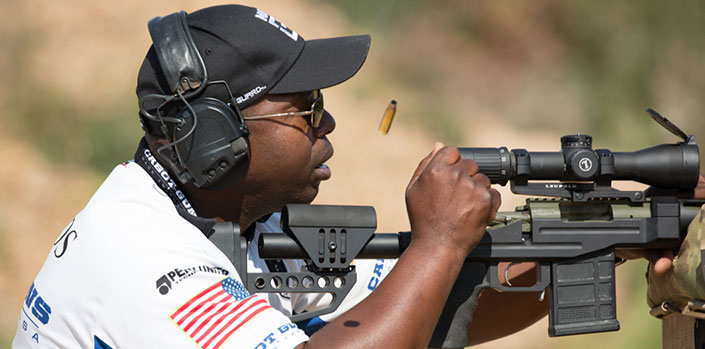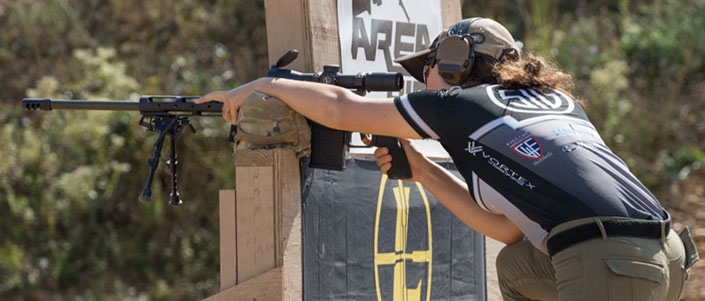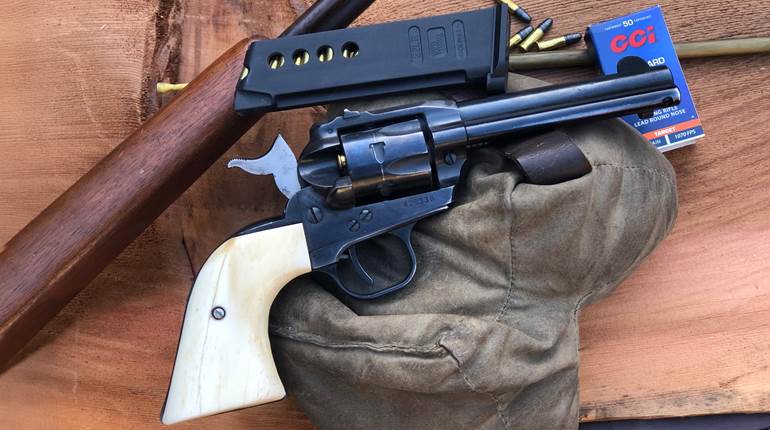
At this match, competitors don’t get to use their own guns—they are supplied at each stage.
We want to find the undisputed world champion.” This was NRA Competitions Division Director Cole McCulloch’s statement opening the shooter’s brief for the 2017 NRA World Shooting Championship. The ballroom of the match hotel was packed with nearly 300 competitors, and the gravity of McCulloch’s declaration was felt by all assembled. The singular, best-all-around shot in the world. That’s a heavy title, and the $250,000 prize purse to be split among the top shooters put a fine point on how hard they were going to try and win. The room was packed with Bianchi Cup winners, USPSA champs, 3 Gun Nation title holders, reality show contestants, a wide variety of armed professionals and a solid crowd of amateur shooting enthusiasts. All were ready to compete.
The World Shooting Championship (WSC) is a relatively new event, the 2017 match being only the fourth, so it is likely that the concept and format are unfamiliar to many. Broadly, shooters compete across 12 stages, each drawn from a unique competitive discipline that emphasizes an aspect of rifle, pistol or shotgun (or a combination of the three). Being a specialist in a certain discipline or two guarantees only that a shooter will have a leg up in a small portion of the championship. Wimbledon Cup holder? Great. How well do you shoot Bianchi-style action pistol and wobble trap? IPSC champion? Fantastic. How good are you with a precision rifle and an over-under shotgun? This event has much more in common with the old History Channel “Top Shot” program than it does Camp Perry.

Shooters fired four events each day for three days at the magnificent Peacemaker National Training Center in Glengary, W.Va. The match has staked out an annual spot in September, so the rolling hills of the old farmlands were breathtaking Americana, with leaves just beginning to turn bright colors and drift in the wind. The listing the bottom gives a sense of the span of events—seven with rifles, six with pistols and three with shotguns.
Besides the broad swath of shooting skill required, the other wrinkle in the WSC is that all events are shot with sponsor-provided equipment. Across the match, shooters fired 16 different guns from nearly as many makers. This was a draw for some of the amateur shooters who admittedly participated mainly for the experience of shooting a huge pile of high-end firearms (with provided ammunition) that they may otherwise never handle in different settings. For the professionals, who were “in the hunt,” it was a source of not inconsiderable stress, having to walk into a stage and fire for score with a perhaps completely unfamiliar firearm. As an example, during a given year I teach with, consult on or review a pretty wide range of firearms—likely a good bit more than the average bear. Among the firearms used during the 2017 World Shooting Championship, I had experience with just eight of the 16 stage guns.
Across the history of competitive shooting, different approaches have been taken to determine the winner and, hence, the “best” shooter. Going back to well before formal competitions, pioneers tried to fire their longrifles closest to the mark, which developed over time into scoring rings and numbered scores. Later, our very own NRA was formed in the 1870s as shooters began to stretch the potential of the then-new breechloading cartridge rifles, firing at ever-farther targets to determine who was best, and setting the basic framework of long-range matches in places such as Creedmoor, N.Y. A more recent development in competitive shooting was to factor in speed, with the fast-draw craze of the 1950s morphing into “combat” and practical matches we know today such as USPSA, IDPA, Steel Challenge, etc., where a shooter’s time plus penalties for poor hits is the basis for score. The World Shooting Championship takes cues from all of these traditions. There were scored events, timed events and long-range targets to contend with. The exact blend and emphasis is probably a never-solvable campfire debate topic, but there was something to touch every skillset within the championship.

There is an art to making 12 scored stages consistent and fair for several hundred competitors. They must be challenging enough to accurately discriminate “great” from merely “good” performance, yet simple enough to remain accessible for the amateur shooters and to keep the match running on time. For someone like me, who has run or been responsible for large military training events/exercises, this was the hallmark of the WSC. Each stage represented its competitive discipline well, was at once challenging and straightforward, and was remarkably well-administered by the range officers.
The difficulty level was entirely appropriate for a match with “World Championship” in the title, with stages that stretched a shooter across a range of skills and knowledge. A perfect example was the Designated Marksman Challenge on Stage 9. The shooter had a bank of three identical, roughly 12"-wide reduced silhouette steel targets placed a few strides short of 500 yds. After two rounds for impromptu sighter shots and a nervous deep breath followed by a head nod to the official, the buzzer sounded. Each shooter had but 13 rounds to engage the three targets from each of three separate positions. The first position had the shooter firing a JP Enterprises .308 Win. semi-automatic rifle from a barricade, the second position engaged the three steel targets from over the top of a wobbly 55-gallon drum, and the final featured a small mound of sandbags that allowed an awkward prone position. Shooters had a maximum of 180 seconds to attempt to hit the nine targets from the improvised rests with the unfamiliar rifle and optic.

There was a full-value crosswind blowing while my squad fired the stage, so there was an included requirement to not only be able to shoot, but also to have a working knowledge of windholds and ballistics to apply the right aiming point inside of the supplied Nightforce optic. Those who didn’t were frustrated as they broke well-centered shots only to see impacts kicking up dirt considerably off to the side. The difficulty level of this particular stage would be right at home at any of the specialized military advanced sniper courses. The best performance on the stage was an impressive 66 seconds with all hits. I lost track of a couple of make-up shots and was incredibly relieved when I hit the final target with my 13th—and final—round as the bolt locked back on the empty magazine.
Another example of both skill and knowledge was the five-stand clays course. The different shooting stations had shooters facing doubles coming from multiple target throwers placed at all sorts of challenging angles around some natural rolling terrain. This gave each competitor just a few seconds to think about the incoming/outgoing targets and to select which barrel (and resulting choke) to fire first on the Mossberg over-unders before calling “Pull!” More than a few shooters admitted sheepishly that they simply loaded two shells and hoped for the best, not being able to think through the problem meaningfully on the spot.

Other stages were deceptively simple. The Cowboy Action stage had relatively large steel targets placed between 7 and 15 yds. from the brace of Ruger Bisley Vaqueros and about 25 yds. from the Henry Big Boy lever-action rifle. The shooters provided his or her own difficulty by snatching up the (to many) unfamiliar firearms and attempting to race as quickly as possible—missing shots as a result.
The USPSA stage had shooters moving through a somewhat small shooting box engaging a mix of steel and silhouette targets around barricades with a Walther PPQ in 9 mm Luger, reloading once. Five of the nine silhouettes had “friendly” or “no shoot” targets covering large portions of them, requiring a level of accuracy that would be right at home on any special tactical team. The best performance on this stage came in at a blistering 15 seconds.
The broad array of disciplines and firearms represented ensured that most shooters were trying something new within the match. On my squad, most of the competitors had somewhat casual experience with a single or perhaps two or three disciplines. Even most of the pro-category shooters had true experience within only a slice of the disciplines closest to their specialty. Looking through the scores you could see pretty easily where most of the top 20 shooters’ weak spots were, and it varied. Bullseye pistol is perhaps the most predictable event on the roster, yet many of the top hands struggled there, while the shotgun events dashed a large number of hopes, including mine.
The match makes use of what I think is perhaps the most brilliant conflict-resolution tool I’ve seen in the shooting sports: a “mulligan” card. Each shooter had a card for one free “re-do,” redeemable on any of the stages as long as the shooter called for his or her mulligan immediately upon finishing the scored run on the stage in question. Whether the shooter had issues with the provided equipment or was simply unhappy with the score, the mulligan was there to give a single chance to improve within the match. I found it to be a brilliant device, and when and where to use the mulligan became a source of great internal debate among the shooters. I used mine to re-shoot the Cowboy stage after letting my speed overtake my aim and slip a shot just off of a target. And in proving that there is such a thing as the “curse of the re-shoot,” I ironically repeated the same scratch miss on the mulligan run.

Many questions about the WSC format revolve around the provided stage guns/ammunition/optics. In most of the stages the shooters had at least some opportunity to handle the equipment and dry fire at a ready table while waiting their turn. In most of the stages where distance or precision was involved, the shooters were able to fire a quick sighter and compensate their holds accordingly. The stage guns undeniably provide an “X-factor” that the shooter must overcome, but it works out. For example, I had one rifle and one shotgun that fit me almost comically poorly, resulting in increased challenge. On the other hand, on one stage the rifle was an almost perfect replica of one I’d previously competed with—to include the same stock and optic—while another shotgun was a perfect duplicate of one I’ve shot for years. The match approach assumes that true champions overcome such challenges; I like the approach and concur with the sentiment.
The sponsorial support for the match was exceptional. Each of the stage guns/optics and a great many other prizes were set up on prize tables for both the professional and amateur brackets, with winners selecting from the table in order of their finish. Most of the biggest names in the business were represented, starting with Kimber as the title sponsor and quite a few specialty small businesses. I did notice a couple of huge gunmakers absent, and I hope they correct that and support future championships.
This year’s winner was Greg Jordan, a law enforcement officer and sponsored shooter who has previously won numerous 3 Gun championships. The competition was incredibly stiff, but Jordan prevailed by a comfortable margin, finishing first in the precision rifle and USPSA stages, in the top five of five of the remaining events and top 10 of several others. With performance like that he earned the title as fair and thoroughly as one possibly can, and Jordan can now add “World Shooting Champion” to his resume; at least until next September.

The 2018 NRA World Shooting Championship will be held Sept. 13-15 at the Peacemaker National Training Center in Glengary, W.Va. The competition, gathering the top shooters in the world to compete in virtually every type of major shooting sports discipline—including pistol, rifle, shotgun and combined firearm sports—will crown one competitor the undisputed “World Shooting Champion.” For more go to wsc.nra.org.
The Shooters
The match is intended to move forward as a mix of professionals and amateurs, with the preponderance of the slots held back for amateurs. My squad of 11 shooters was perhaps a perfect cross section of the match and the broader membership of NRA. One other shooter and I were registered as pros, with the balance shooting in the amateur division. The ages of the shooters spanned from the early 20s to mid-60s, with representation from all over the country. One shooter was primarily a trap shooter who was there to try out the different disciplines. Another was a retail clerk in a state with oppressive gun laws, and was there to shoot all of the stage guns and try his luck. There was a Border Patrol agent, who inspired confidence with his abilities, and a couple of veterans. One shooter owned a tire store, another was a program manager for a major defense contractor, while two were engineers and another an electrician. Each tackled the challenges across the match with enthusiasm and thoroughly enjoyed themselves. The shooters swapped stories and tips, compared thoughts on the different stage guns and clapped with genuine support when a member of the squad shot a stage well. Several surprised themselves with very solid runs on different stages, finding themselves on the leaderboard outside the food tent for at least a while, and several pulled nice prizes off of the table at the awards ceremony. All—myself included—are eager to return next year.
—Justin Dyal
Additional Reading:
Video: Highlight Reel—2015 NRA World Shooting Championship
Gallery: Scenes from the 2015 NRA World Shooting Championship






































